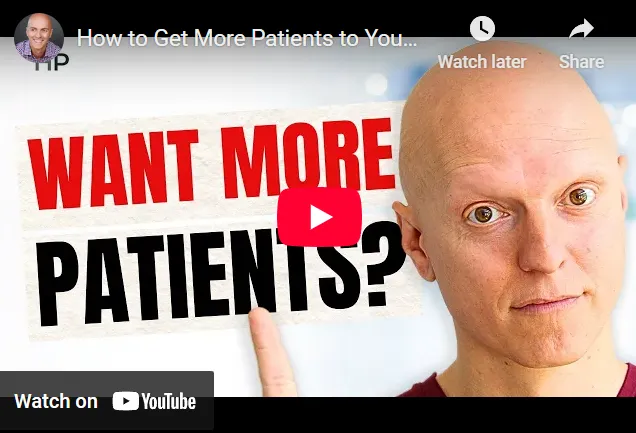How Blogging Can Boost Your Podiatry Practice and Bring in New Patients

In the contemporary digital marketing landscape, blogging has emerged as a significant tool for healthcare professionals, particularly podiatrists. By sharing valuable insights and expertise through a blog, healthcare providers can establish their authority, enhance patient education, and substantially increase their online visibility. This article examines the benefits of blogging for podiatry practices, outlines practical steps to initiate a blog, and offers strategies for effectively promoting your content. Explore how to utilize this platform to attract patients, enhance website traffic, and expand your practice.
Key Takeaways:
- Establish your authority and brand credibility by consistently blogging about podiatry topics that are relevant to your target audience.
- Increase your online visibility and reach by promoting your blog on social media channels, collaborating with other healthcare professionals, and utilizing email marketing.
- Improve patient education and engagement by creating quality blog content, optimizing for SEO, and interacting with readers through visuals and multimedia, including video content.
What is Blogging?
Blogging serves as a highly effective online marketing tool for healthcare professionals, including podiatrists, enabling them to create compelling content that significantly enhances their online presence.
Through well-crafted blog posts, practitioners can educate patients on various foot care topics, share success stories, and promote their podiatry practices, ultimately leading to increased website traffic and the attraction of new patients, contributing to practice growth.
Furthermore, blogs provide a valuable online marketing platform for demonstrating expertise and establishing brand credibility, thereby allowing practices to distinguish themselves in a competitive healthcare landscape.
Why Should Podiatrists Consider Blogging?
Podiatrists should regard blogging as a vital element of their marketing strategies, as it greatly enhances online visibility and patient engagement.
By offering informative content on foot health, practitioners can effectively attract potential patients who are seeking information related to bunion surgery, diabetes foot care, or general foot care tips.
Furthermore, blogs contribute to improved local search rankings, ensuring that the podiatry practice location is prominently featured in search results on Google Business Profile and through Google Ads and other platforms, ultimately leading to an increase in appointment bookings.
1. Establishes Authority and Credibility
One of the primary benefits of blogging for podiatrists is the establishment of authority and credibility within the field of foot health. By consistently publishing well-researched articles on pertinent topics, such as common foot conditions and treatment options, practitioners can position themselves as experts in podiatry, thereby fostering trust among both potential and existing patients through patient testimonials and reviews.
Incorporating patient testimonials and success stories into blog content further enhances this effect by highlighting real-life experiences and positive outcomes. These narratives not only add a personal touch to the service but also demonstrate the effectiveness of treatments, thereby reinforcing trust among prospective patients.
Through healthcare marketing strategies and content optimization that leverage storytelling, podiatrists can improve their online presence and cultivate a more relatable and credible image. As the healthcare industry increasingly focuses on patient-provider relationships, such initiatives are essential for building enduring connections and establishing a loyal patient base as part of a comprehensive marketing plan.
2. Increases Online Visibility and Reach
Blogging plays a pivotal role in enhancing online visibility and reach for podiatry practices through the effective utilization of SEO keywords. When practitioners produce content that is optimized for search engines, such as Google, their websites are more likely to achieve higher rankings in search results. This, in turn, leads to increased website traffic and a greater number of patient inquiries.
By incorporating relevant SEO keywords that potential patients are likely to search for, podiatry practices can ensure that their services are readily discoverable. Furthermore, employing local search strategies can significantly enhance this visibility, as patients often prefer to find nearby providers.
Engaging and informative content not only aids in refining SEO but also fosters trust with the audience, establishing the practice as a reputable resource in foot and ankle care.
Ultimately, the integration of effective digital marketing strategies and community outreach encompassing strategic keyword research and tailored content can substantially elevate a podiatrist’s online presence and attract a consistent influx of new patients.
3. Improves Patient Education and Engagement
Enhancing patient education and engagement represents a significant rationale for podiatrists to adopt blogging as a communication tool. By developing informative blog content that addresses prevalent foot health inquiries and by sharing engaging video materials, practices can enable patients with knowledge that fosters proactive healthcare decisions, including the timely scheduling of appointments.
For example, a podiatrist might highlight the significance of appropriate footwear by publishing a series of articles complemented by patient testimonials and images of real patients demonstrating their transformations.
Additionally, employing infographics to elucidate complex subjects, such as the risk factors associated with diabetic foot ulcers, can greatly improve patient understanding.
Encouraging comments and discussions on blog posts further cultivates a sense of community and enhances patient engagement, ensuring individuals feel valued and acknowledged.
By incorporating multimedia elements, such as brief educational videos or interactive quizzes, practitioners can cater to diverse learning preferences, ultimately contributing to improved patient retention and promoting healthier outcomes in their foot health journeys, enhancing overall healthcare experiences.
How to Start a Blog for Your Podiatry Practice
Initiating a blog for a podiatry practice entails several critical steps that are fundamental to its success in attracting patients and enhancing online presence.
Firstly, selecting an appropriate blogging platform is essential, as it influences both ease of use, website design, and the customization options available.
Subsequently, identifying the target audience and the specific foot care topics to be addressed will guide content creation efforts, enabling the provision of high-quality material that effectively resonates with readers.
1. Choose a Blogging Platform
Selecting the appropriate blogging platform is essential for the success and brand visibility of a podiatry practice’s online presence, as it directly affects website design, functionality, and user experience. A user-friendly platform enables practitioners to efficiently publish content, manage posts, and engage with patients.
Platforms such as WordPress and Wix provide healthcare professionals with customizable templates specifically designed for healthcare professionals, ensuring that the website is not only visually appealing but also compliant with industry standards. Furthermore, these platforms frequently incorporate built-in SEO tools that can enhance visibility and attract a greater number of patients through organic search.
Healthcare practitioners can also benefit from the integration of social media sharing options, which promote patient engagement and foster community interaction.
By employing these marketing strategies and engaging in healthcare business initiatives, professionals can establish a robust online presence that educates patients and disseminates valuable insights, thereby enhancing their practice’s credibility in a competitive landscape.
2. Define Your Target Audience and Topics
Defining the target audience and the topics to be addressed in a blog is crucial for developing content that resonates with potential patients, enhances engagement, and aligns with marketing goals. For a podiatry practice, a thorough understanding of the demographics and interests of the audience can facilitate the selection of topics that focus on common foot health issues, treatment options, and preventive care measures.
Utilizing methods such as patient surveys and community events can yield valuable insights into the specific concerns and inquiries of patients, allowing for a more targeted approach. Furthermore, analytics tools can identify patterns in engagement, thereby highlighting which topics generate the most interest.
By selecting relevant subjects such as diabetic foot care, bunion surgery, children’s foot development, or sports injuries, practitioners can foster a sense of community among readers.
Incorporating strategic keywords related to foot health and SEO can enhance searchability, while also encouraging meaningful discussions. Engaging patients with informative infographics and inviting feedback through interactive content can further deepen their investment in both the blog and the practice.
3. Create Quality Content
Creating quality content is fundamental to the success of a podiatry practice of a podiatry blog, as it serves to inform and effectively engage patients. Well-researched blog posts that incorporate multimedia elements and marketing collateral, such as images and videos, can enhance the user experience, capture attention, and promote sharing across social media platforms.
Plus engaging visuals, the writing style is crucial in shaping how readers perceive the information. Utilizing clear, concise, and relatable language can render complex medical concepts more accessible to a broader audience.
Moreover, high-quality content must be optimized for search engines and aligned with marketing agency standards; incorporating relevant keywords and metadata throughout the writing improves visibility and attracts a larger audience.
By thoughtfully integrating these elements thorough research, engaging multimedia, and effective SEO strategies bloggers can produce content that not only informs but also serves as a valuable resource, fostering trust and confidence in podiatric care among patients. Highlighting foot health and foot care can further enhance the content’s value.
4. Optimize for SEO
Optimizing a podiatry blog for search engine optimization (SEO) is essential for enhancing its visibility on platforms such as Google, which directly influences website traffic and patient acquisition. Incorporating effective marketing strategies can further boost your online presence.
Strategically incorporating relevant SEO keywords and digital marketing terms throughout the content, including in titles, headings, and meta descriptions, can significantly improve the blog’s search engine rankings.
Conducting comprehensive keyword research facilitates the identification of high-traffic terms commonly searched by potential patients. Coupling this with effective on-page SEO techniques such as optimizing images, implementing internal linking, and creating compelling call-to-action buttons can enhance user engagement and improve overall content optimization.
Furthermore, establishing a robust network of backlinks from reputable websites not only bolsters the authority of the blog but also fosters increased trust from both search engines and readers. This comprehensive approach not only enhances content optimization but ultimately cultivates a more engaged patient community eager to learn about and interact with the services offered. Working with a marketing agency can further enhance these efforts.
How to Promote Your Blog and Attract New Patients
Effectively promoting your blog is essential for attracting new patients and enhancing engagement with existing ones. Utilizing digital marketing strategies can significantly improve these efforts.
By utilizing various channels, including social media, email marketing, and community outreach, you can significantly expand the reach of your content and drive practice growth.
This increased visibility will drive more visitors to your podiatry practice’s website, ultimately resulting in a higher number of appointment bookings. Utilizing tools like Google Ads can further enhance this visibility.
1. Share on Social Media
Sharing blog content on social media channels serves as an effective strategy to enhance online presence and engage with patients. By posting informative articles and engaging video content, a broader audience can be reached, encouraging shares and comments that foster community interaction. Leveraging patient testimonials can also enhance brand credibility.
To maximize impact, it is essential to establish a consistent posting frequency, as this practice has been shown to keep content prominent in the minds of followers. Research indicates that posting during optimal times, such as early mornings or late afternoons when users are most active, can significantly improve visibility and engagement rates. Utilizing a content calendar can help maintain this consistency.
Furthermore, diversifying the types of content shared, including infographics, patient testimonials, and live Q&A sessions, can enhance patient engagement and establish a stronger connection with the audience. Highlighting patient success stories can also enhance these efforts.
Effectively leveraging social media not only increases awareness but also builds trust, making it a vital component of healthcare marketing strategies. Engaging with local dermatologists and other specialists can expand your referral network.
2. Collaborate with Other Healthcare Professionals
Collaborating with other healthcare professionals represents a strategic approach to expanding referral networks and enhancing community outreach. By engaging in guest blogging or participating in joint events, podiatrists can effectively cross-promote their services and content, thereby attracting new patients and augmenting their online marketing initiatives. Partnering with other specialists can also improve content optimization.
Moreover, establishing partnerships with local clinics and specialized medical practitioners not only enhances the credibility of individual practitioners but also fosters a supportive network that can facilitate increased patient referrals. Networking with healthcare providers at community events can also strengthen these partnerships.
For example, a podiatrist collaborating with a physical therapist to conduct joint workshops on foot health can significantly enhance visibility within the community. Such professional collaborations not only contribute to improved patient outcomes but also promote a holistic approach to care. They can also share marketing ideas to further enhance their outreach.
Additionally, networking events and health fairs provide excellent opportunities for healthcare providers to share resources and engage with their community, ultimately strengthening their reputation and fostering trust among potential patients. Promoting your practice location within these communities can further boost patient acquisition.
3. Utilize Email Marketing
Utilizing email marketing represents a highly effective method for keeping patients informed and engaged with your podiatry practice. By regularly dispatching newsletters that highlight blog content, share patient success stories, and provide appointment booking reminders, you can strengthen relationships and encourage repeat visits. This can be further supported with tailored marketing collateral.
To further enhance engagement, it is advisable to segment your email list based on patient demographics or treatment history. This approach allows for the delivery of tailored content that resonates with each specific group. Highlighting services like bunion surgery can target specific patient needs.
Providing educational materials related to foot health, recovery tips, or seasonal reminders about foot care can also enhance the value of your communications. These materials can improve brand credibility and patient trust.
Establishing a consistent communication schedule, whether on a weekly or monthly basis, is crucial for maintaining awareness and reaffirming the practice’s commitment to patient well-being. Additionally, employing engaging subject lines and clear calls to action can significantly improve open and click-through rates, thereby enabling effective engagement strategies that keep your practice prominent in patients’ minds. Utilizing an effective marketing plan can streamline these efforts.
4. Attend Networking Events and Conferences
Attending networking events and conferences offers podiatrists valuable opportunities to connect with peers and potential patients, thereby enhancing their marketing strategies and community outreach efforts. Participation in these events facilitates the establishment of professional relationships, the exchange of knowledge, and the effective promotion of the podiatry practice. Engaging in local search optimization can further boost visibility within your community.
These gatherings encourage collaboration among healthcare professionals, allowing practitioners to share innovative treatment techniques and successful business strategies that can elevate their services. By engaging with such a community, podiatrists can access a wealth of resources and referral networks that significantly expand their patient base. Collaborating on shared marketing tactics can also enhance these efforts.
Moreover, community involvement fosters a deeper understanding of local health concerns, enabling the development of tailored marketing approaches that resonate with specific audiences. Ultimately, investing time in networking can lead to improved visibility, enhanced patient trust, and increased growth opportunities within the healthcare business landscape. Promoting your Google Business Profile can further enhance local visibility.
Measuring the Success of Your Blog
Measuring the success of a podiatry blog is essential for understanding its effectiveness and impact in attracting new patients. By analyzing website traffic, user engagement metrics, and patient feedback, practitioners can obtain valuable insights into content performance. Monitoring online reviews can also provide valuable insights into patient satisfaction.
This data enables them to make informed decisions regarding future marketing strategies and marketing goals.
1. Track Website Traffic and Engagement
Tracking website traffic and engagement is a critical component in evaluating a blog’s success and its effectiveness in patient acquisition. By utilizing analytics tools, podiatrists can monitor visitor behavior, identify popular content, and assess engagement rates, thus gaining valuable insights into what resonates with their target audience. Understanding your ideal patient can further refine these insights.
Focusing on specific metrics, such as page views which indicate the volume of traffic and bounce rates which reveal the effectiveness of content in retaining visitor interes”practitioners can achieve a deeper understanding of user engagement. Additionally, tracking session durations provides insight into how long visitors are interacting with posts, offering significant data regarding content quality. Monitoring other key performance indicators like conversion rates can further enhance these insights.
By systematically analyzing these metrics, podiatrists can refine their blogging strategies, creating content that not only attracts patients but also engages them effectively. This approach ultimately enhances their online presence and supports successful patient acquisition efforts. Partnering with a marketing agency can further optimize these strategies.
2. Monitor Patient Feedback and Referrals
Monitoring patient feedback and referrals is essential for assessing the effectiveness of a blog and its impact on patient engagement. By actively managing online reviews and gathering testimonials, podiatrists can obtain valuable insights into patient perceptions and identify areas requiring improvement. Utilizing reputation management techniques can further enhance these efforts.
Utilizing surveys can serve as an effective means of collecting important feedback, as they enable the formulation of targeted questions that explore patient experiences in greater depth. Additionally, leveraging various online review platforms provides patients with a space to express their opinions in an open forum. This not only facilitates an understanding of patient satisfaction levels but also plays a critical role in reputation management. Engaging with patient reviews can also provide valuable insights.
Establishing strong relationships with patients depends on demonstrating that their opinions are valued, which ultimately fosters trust and loyalty. Collectively, these strategies lay the groundwork for enhanced patient interactions and an improved reputation for the practice. Incorporating patient success stories in communications can further build these relationships.
3. Use Analytics Tools
Utilizing analytics tools is crucial for evaluating the performance of a blog’s website and understanding its role in achieving marketing objectives. By leveraging these tools, podiatrists can identify trends, monitor user behavior, and optimize their content to enhance patient acquisition efforts. Analyzing data from your Google Business Profile can further refine these insights.
These platforms facilitate comprehensive analysis of key performance metrics, such as page views, bounce rates, and conversion rates, providing valuable insights into the content that resonates most effectively with the audience. Tracking engagement strategies across various marketing channels can further enhance this analysis.
By consistently monitoring these analytics, practitioners can make informed, data-driven decisions that refine their strategies and enhance user engagement. This iterative process of content optimization not only improves the relevance of the information shared but also increases the overall effectiveness of the website, ultimately driving higher patient engagement and fostering stronger connections within the community.
Common Mistakes to Avoid in Blogging for Your Podiatry Practice
Avoiding common mistakes in blogging is essential for the growth and effectiveness of a podiatry practice’s online content strategy.
By identifying pitfalls such as inconsistent posting, lack of audience engagement, and insufficient SEO practices, practitioners can improve their blogging efforts and foster a stronger connection with their target audience.
1. Not Posting Consistently
A frequent oversight among podiatrists is the lack of consistent posting, which can impede patient engagement and reduce the effectiveness of the blog. Establishing a content schedule is essential to ensure regular updates, thereby keeping the audience informed and engaged on matters related to foot health.
Maintaining a harmonious posting frequency not only cultivates trust but also encourages readers to return for new insights. By developing a content calendar, professionals can strategically plan topics that coincide with seasonal trends, health awareness months, or community events.
This organized methodology facilitates the production of content that resonates with patients, ultimately enhancing engagement through meaningful interactions. Regular postings are known to improve SEO, increasing the blog’s visibility, and this consistency demonstrates a commitment to providing valuable information.
Over time, the process of building a loyal audience becomes effortless as readers come to appreciate the reliability of well-timed, informative updates on foot health and related topics.
2. Not Having a Clear Call to Action
Failing to include a clear call to action in blog posts can significantly impact patient engagement and diminish opportunities for appointment bookings. Podiatrists should effectively guide readers toward the next steps, whether that involves scheduling an appointment, subscribing to a newsletter, or sharing content on social media.
By integrating strategic calls to action, practitioners can create a seamless pathway that enhances the likelihood of patient interaction and ultimately advances their marketing objectives. Ensuring that each blog post encourages action not only keeps patients informed but also fosters a sense of community and trust.
Implementing effective engagement strategies, such as offering valuable resources or incentives for referrals, can further motivate patients to participate actively. When practices prioritize these components, they not only improve engagement but also pave the way for higher conversion rates and the development of a loyal client base.
3. Not Utilizing Visuals and Multimedia
Neglecting to utilize visuals and multimedia within blog content can restrict patient engagement and diminish the overall readability of the posts. The integration of images, infographics, and videos significantly enhances the content experience, rendering topics such as foot health more accessible and engaging.
By creating a more dynamic reading experience, these elements serve to capture attention and facilitate the conveyance of complex information in a simplified manner. Visuals not only break up dense text but also improve retention rates, allowing readers to better absorb essential health information.
Furthermore, when optimizing for search engines, the inclusion of relevant alt text and captions can substantially enhance SEO performance, thereby increasing the content’s discoverability. As patients increasingly turn to online resources for their health needs, employing multimedia techniques can promote a greater sense of connection, fostering more meaningful interactions and trust between providers and patients.
4. Not Engaging with Readers and Responding to Comments
Failing to engage with readers and neglecting to respond to comments can alienate the audience and diminish the overall effectiveness of a blog. Podiatrists should actively participate in discussions, addressing questions and feedback to cultivate a sense of community and enhance their online presence.
Establishing a loyal following relies on the dynamic interaction between content creators and their audience. When podiatrists invest time in engaging with thoughtful comments or straightforward inquiries, it not only enhances viewer satisfaction but also encourages others to participate in the conversation.
This interaction fosters a vibrant community where knowledge is both shared and valued, thereby reinforcing their reputation as authoritative figures in foot health. By prioritizing reader engagement, podiatrists not only improve their online visibility but also establish a reliable platform that nurtures connections and promotes ongoing dialogue within their field.

Frequently Asked Questions
1. How can blogging help boost my podiatry practice?
Blogging can be a powerful marketing tool for podiatrists as it allows you to share valuable information about foot health, establish yourself as an expert in your field, and attract potential new patients to your practice. It also enhances your online presence and boosts your website traffic.
2. Will blogging really bring in new patients to my podiatry practice?
Yes, blogging can bring in new patients to your podiatry practice by helping you reach a wider audience and showcasing your expertise, which can make potential patients feel more comfortable and confident in choosing your practice. Engaging with social media channels and patient reviews further supports this strategy.
3. How often should I be blogging to see results for my podiatry practice?
Consistency is key when it comes to blogging for your podiatry practice. Aim to publish at least 1-2 high-quality blog posts per week to keep your audience engaged and attract new readers, while leveraging SEO keywords and content optimization for better visibility.
4. What type of content should I include in my podiatry blog?
Your podiatry blog should include a variety of content, such as educational posts about foot health and common foot conditions, personal stories and experiences, tips and advice, and even promotions or specials for your practice. Incorporating video content and patient testimonials can further enhance patient engagement.
5. Can blogging help improve my search engine ranking?
Yes, blogging can help improve your search engine ranking by providing fresh and relevant content for search engines to index. By using keywords and linking to other reputable websites, you can increase your chances of appearing higher in search results for relevant keywords. Engaging in local search and optimizing your Google Business Profile are also effective tactics.
6. Do I need to be a tech-savvy podiatrist to start a blog?
No, you do not need to be a tech expert to start a blog. There are user-friendly blogging platforms and templates available, or you can hire a marketing agency to set up and manage your blog for you. The most important thing is to focus on creating high-quality content that will attract and engage your audience, enhancing your brand credibility and supporting your healthcare marketing goals.










